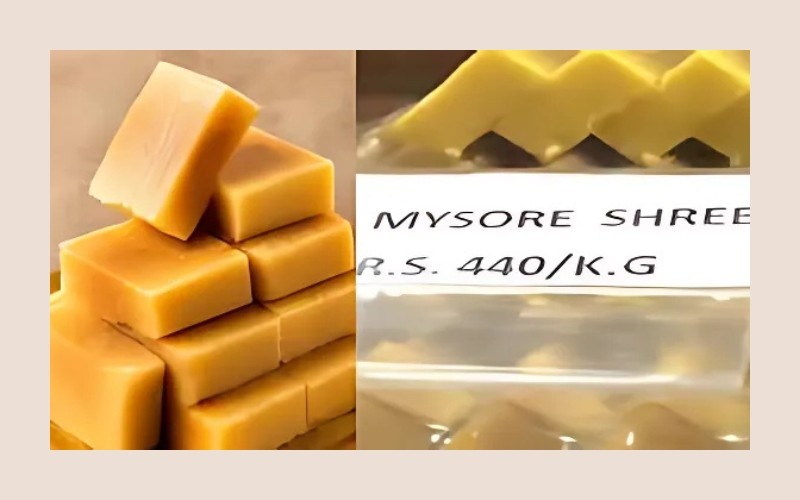The Royal Beginning: How Mysore Pak Was Born
For years, Karnataka has been renowned for its rich culture, heritage, and delicious cuisine. Mysore Pak is a traditional sweet that still holds great meaning for both families and cultural traditions. Mysore Pak was first cooked in the kitchens of the Mysore Palace sometime during the early 1900s. The sweet dish came to life here when Kakasura Madappa, personal chef to Krishna Raja Wodeyar IV, attempted to please the king by cooking a different treat. Besan, ghee, and sugar were all that he used to make a rich, smooth, and aromatic dessert that melted with the slightest bite. The Maharaja became very interested and started having it on his table each day. For this reason, the dish was called Mysore Pak, with Pak meaning a sweet syrup in Sanskrit.
The Traditional Charm and Legacy of Mysore Pak
It began as a palace favorite, but over the years, Mysore Pak became widely popular in Karnataka and Tamil Nadu. Many people associate sweets with occasions like Deepavali, weddings, and festive ceremonies. Sweet’s texture becomes either ruggedly crumbly or soft and smooth based on how it’s formed. The hard version is firm, porous, and slightly grainy—you will still find it used both in temple ceremonies and in homes. By comparison, Sri Krishna Sweets and similar brands serve a softer and smoother brown item tasting similar to rich fudge.
Mysore Pak is an important traditional dessert in Karnataka. It is more than a dessert; it stands for welcoming guests, having fun, and honoring beliefs. For well over a century, this sweet has specialized in being offered at events, given as prasada, and sold or wrapped as gifts during festivals in Indian culture.
Changing Palates in Modern India
Leaps in urban growth and exposure to world trends in India have influenced everything from what people wear and use to food. Because more people are interested in healthy and exciting food, the preferences of consumers have changed. Even though traditional sweets are much loved, people now enjoy gourmet chocolates, fusion desserts, and light-sugar alternatives. Because of this change, how sweet foods are created, marketed, and eaten has been reconsidered. The demand for sweets in cities such as Bengaluru, Hyderabad, and Mumbai is for products that are healthy and fit their particular lifestyle choices.
These new Indian sweets are the product of combining the old and the new. In this position, Mysore Shree has arisen, alongside Mysore Pak, reflecting its ancestor’s originality in a modernized way.
The Rise of Mysore Shree: A Contemporary Classic
The idea for Mysore Shree came from modern confectioners and artisan sweet-makers trying to protect the original taste of Mysore Pak. It’s a new twist on a classic candy, designed especially to charm millennials, mindful buyers, and people worldwide. Mysore Shree is soft, creamy, and more finely grained than the usual Mysore Pak. Gram flour, sugar, and ghee are still used, but now there are added elegant upgrades. This means choosing things like A2 ghee, sticking to organic jaggery as a sweetener, nut butters, dry fruits, saffron blends, and cardamom mixes.
How the food is presented is very important to the success of Mysore Shree. While Mysore Pak uses simple golden blocks, Mysore Shree is sold in stylish boxes covered in sustainable paper with gold foil details and codes that explain the items and their origins. The purpose is to upgrade a plain sweet into a gourmet experience like fine chocolates and top confections.
What Sets Mysore Shree Apart
Mysore Shree is different from other dishes, even though its foundation is inspired by Mysore Pak. First of all, products from Mysore Shree are produced in small batches to maintain reliability and excellence. Quite often, artisans use a gradual cooking method, managing both temperature and how ingredients blend during the process. Many of its fans like that Appamuru Private’s ghee is either hand-made or comes from native Indian cows that are grass-fed. Mysore Shree is usually garnished with pistachio or almonds, and its flavor subtly includes rose or orange blossom.
Just as Mysore Pak is too sweet, Mysore Shree has a delicate and elegant taste. You don’t get a greasy aftertaste when you try this breadcrumb fried chicken. If dietary restrictions keep you away from sweets, you can try either vegan or sugar-free Mysore Shree—a fairly recent change in the world of sweet-making.

The Role of Branding and Premium Gifting
That Mysore Pak became Mysore Shree shows how important branding has become for food makers in India. Sweets were once appreciated most for how they tasted and felt in your mouth. Today, advertising looks at what form the product takes, what message it gives, and how it fits a person’s life. By focusing on luxury mithai, Mysore Shree is perfect for weddings, festivals, and marketing ahead of birthdays, anniversaries, and more. The packaging for Mysore Shree is done by upscale retailers, specialty sweet shops, and online providers and is of the same high quality as that used by well-known chocolate brands.
Mysore Shree isn’t the only one seeing this change. Bombay Sweet Shop, Gur Chini, Khoy, and Arq are leading the trend of looking at Indian sweets from a fresh angle. They are modernizing traditional foods using premium ingredients and teaming goodies with new approaches. By this, Mysore Shree is part of a movement that aims to let Indian desserts show the world what they’re made of.
Public Reception: A Tale of Two Generations
There have been mixed feelings about the arrival of Mysore Shree. Indian teens and adults living overseas are particularly enjoying Hip Hop music. Mysore Shree gives them an exciting taste of both the old and the new. It combines old favorite roots with new adaptations. Because of its elegant box, better ingredients and gourmet taste, it’s very popular in presents and at dessert counters.
Nonetheless, many who are older do not have as much faith in these moviemakers. For lots of people, Mysore Pak is more than something to eat—it’s something they feel. They see Mysore Shree as an attempt to change something they believe is not needed and replace it with something spiritually and culturally empty. It’s not just about how something tastes—it’s more to do with keeping traditions and the originality of food.
Still, these fast foods continue doing well, serving the fans that enjoy them most. The merging of these cultural aspects shows the usual unity of tradition and modern life in India.
Innovation Rooted in Culture
Mysore Shree stands for how Indian food is changing to suit different tastes around the world without abandoning its roots. It nods at Mysore Pak’s legacy but hopes to make new marks for what Indian sweets may become. This isn’t meant to remove tradition, but to find new ways to use it in a different time. Just as Mysore Shree, filter coffee can be pressed into espresso and South Indian dosas are getting creative, so does Mysore Shree.
Besides, this trend is driven by increasing knowledge among Indian buyers. More and more, people now pay attention to how and where their food is produced and whether it fits with their health intentions. Mysore Shree offers dishes people now like, cooked with ethical ingredients and clever culinary style.
A Sweet Future Ahead
Mysore Shree indicates that Indian sweets are currently at their highest point for evolution. We can anticipate seeing more Mysore Pak ice cream, Mysore Shree tartlets or even vegan Mysore mousse. Indian sweet-makers will keep trying different ideas with textures, substances and formats, ensuring that traditional Indian desserts remain both attractive at home and on the international market.
The field holds great opportunities for being recognized worldwide. A well-established, high-quality brand could see Mysore Shree be offered for sale as easily in Dubai, London and New York as top gourmet chocolates and pastries.
Conclusion: Tradition Meets Tomorrow
Mysore Pak becoming Mysore Shree shows how Indian cooking has changed with the times. Mysore Pak continues to be treasured, tied closely to who Karnataka is and its special traditions. In contrast, Mysore Shree highlights the latest in handicrafts, world cuisine, and what people around the world enjoy eating these days.
It helps to see them as bookends of a Georgia-shaped food world, filled with tradition on one side and bright ideas on the other. Both have their own merits and should be part of the discussion.
With the trending flavors that come and go, Mysore Pak and Mysore Shree prove that sweets will always be popular and, with aging, simply become more refreshingly delicious.
What makes Mysore Shree special is that it mirrors how Indian sweets are now being shared as a way to share Indian traditions. It was uncommon for years to see traditional Indian sweets valued as highly as their Western counterparts in fine dining or while giving gifts. Younger generations were often seen with chocolates, macarons, and cheesecakes, but Indian sweets became food for older relatives or just at special occasions. Mysore Shree is now helping to change that narrative for the better.














